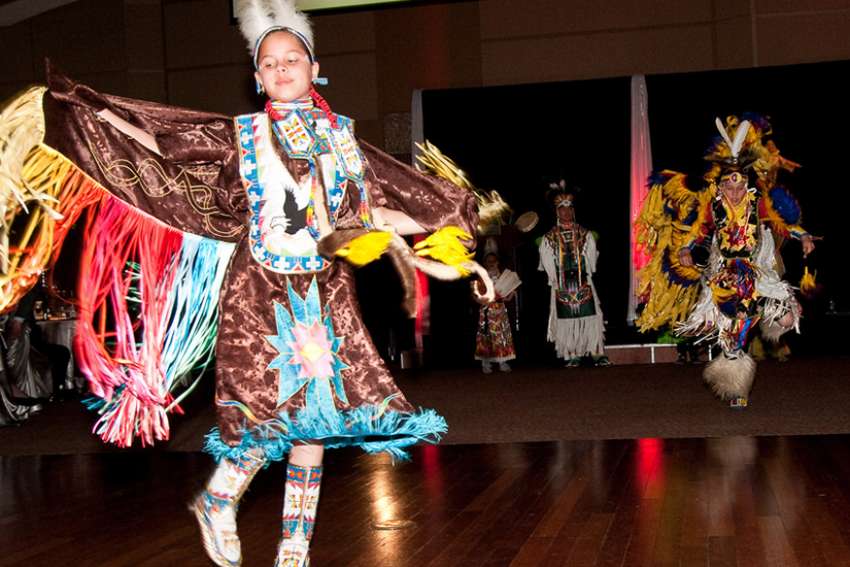In late April, I attended “Ancestors and Elders,” a performance by Edmonton’s Shumka Dancers, Canada’s only professional Ukrainian dance troupe, and two Indigenous dance groups — Running Thunder Dancers and Kehewin Native Dance Theatre.
The spectacular performance raised reconciliation between Indigenous people and settler Canadians to a different level. The three dance groups performed individually and together, the highlight being the participation of the First Nations dancers in the swirling, exuberant Ukrainian national dance, the Hopak.
The program introduction, written by Shumka’s executive director, Darka Tarnawsky, noted many similarities between First Nations and Ukrainian culture — a reverence for the Earth, respect for ancestors and elders, the beauty found in beading, braiding and embroidery, and the importance of family, prayers and blessings.
Left unmentioned were differences such as Ukraine’s Christian heritage in distinction from Aboriginal spirituality and a circular concept of time, as well as the hunting and gathering nature of traditional Indigenous life versus the European agriculture’s reliance on tilling the soil.
Still, what is important is that the two cultures were brought together through dance. For decades, First Nations and government, Church and other settler groups have come together in verbal dialogue. Representatives of the dominant society have issued numerous apologies, only to hear demands for still more repentance.
One cannot say that two performances “solved” anything, but it did add a new level to our understanding of dialogue. Through dancing the Hopak together, a deep bond — a sort of marriage — can be formed.
Ours is a highly intellectual culture with heavy emphasis on the meanings of words, both spoken and written. We hardly recognize that speech is only one way to convey meaning. But music, dance and ritual express meaning in ways not easily intellectualized.
One would think that we would tire of endless efforts to express ourselves with words alone. Still, the number of speeches, lectures, academic articles, legal contracts and organizational policies multiply with each passing year. At the same time, we become estranged from our bodies, becoming less fit, less coordinated and less physically flexible. Our ability and willingness to “speak” with our bodies diminishes.
Maurice Merleau-Ponty, a mid-20th century Catholic philosopher, maintained that thought is not an internal process independent of the body. In receiving another’s speech or gestures, “it is as if the other person’s intention inhabited my body and mine theirs…. It is through my body that I understand other people.”
Dance is a biblical form of praise and celebration. The return of the prodigal son was celebrated, not with speeches by dignitaries, but with singing and dancing (Luke 15.25). When the Ark of the Covenant was brought to the Temple in Jerusalem, “David and all Israel were dancing before God with all their might” (1 Chronicles 13.8).
Praise is the centre of human living. What we praise defines who we are. If our highest praise goes to hockey players and lottery wins, we are extolling false gods. If we sing, “Glory to God in the highest,” we give right praise — praise to the One who is beyond all praising.
When people from two cultures express themselves through dance, a bond is formed. They express what is most essential to them with a depth that words rarely convey. The possibility of reconciliation opens up by way of their common praise. Through their bodies they inhabit each other’s realm of being.
How can we know reconciliation has taken place? Surely, signed agreements and public pronouncements fall short. We better recognize reconciliation in its fruits, the same fruits St. Paul attributes to the presence of the Holy Spirit — love, joy, peace, patience, kindness, goodness, faithfulness, gentleness and self-control. It will take more than a discussion to reach that point.
Maybe if we dance and praise together, we will take large steps toward a joyful and lasting marriage of cultures.
(Argan is the interim editor of Living with Christ.)
Glen Argan: Reconciliation by traditional dance
By Glen ArganWords are rarely enough. Actions speak louder than words. When we want to restore a broken relationship, a simple “I’m sorry” or even a long, detailed apology may not suffice. More is required.
Please support The Catholic Register
Unlike many media companies, The Catholic Register has never charged readers for access to the news and information on our website. We want to keep our award-winning journalism as widely available as possible. But we need your help.
For more than 125 years, The Register has been a trusted source of faith-based journalism. By making even a small donation you help ensure our future as an important voice in the Catholic Church. If you support the mission of Catholic journalism, please donate today. Thank you.
DONATE

